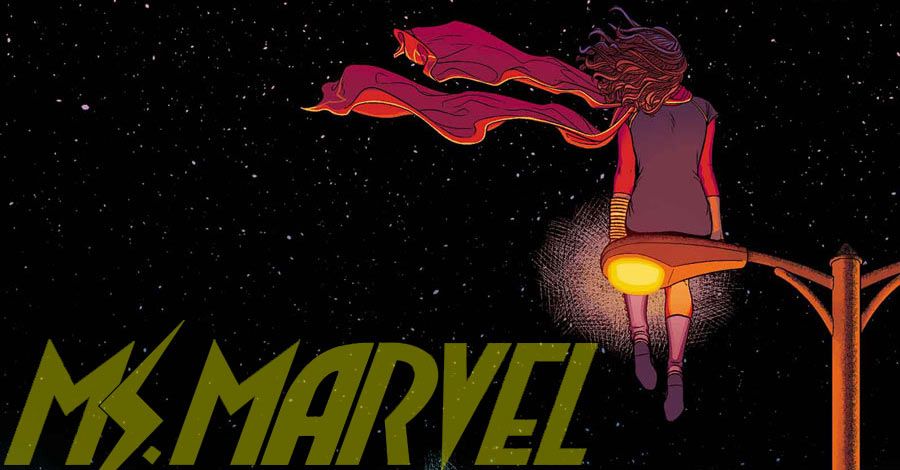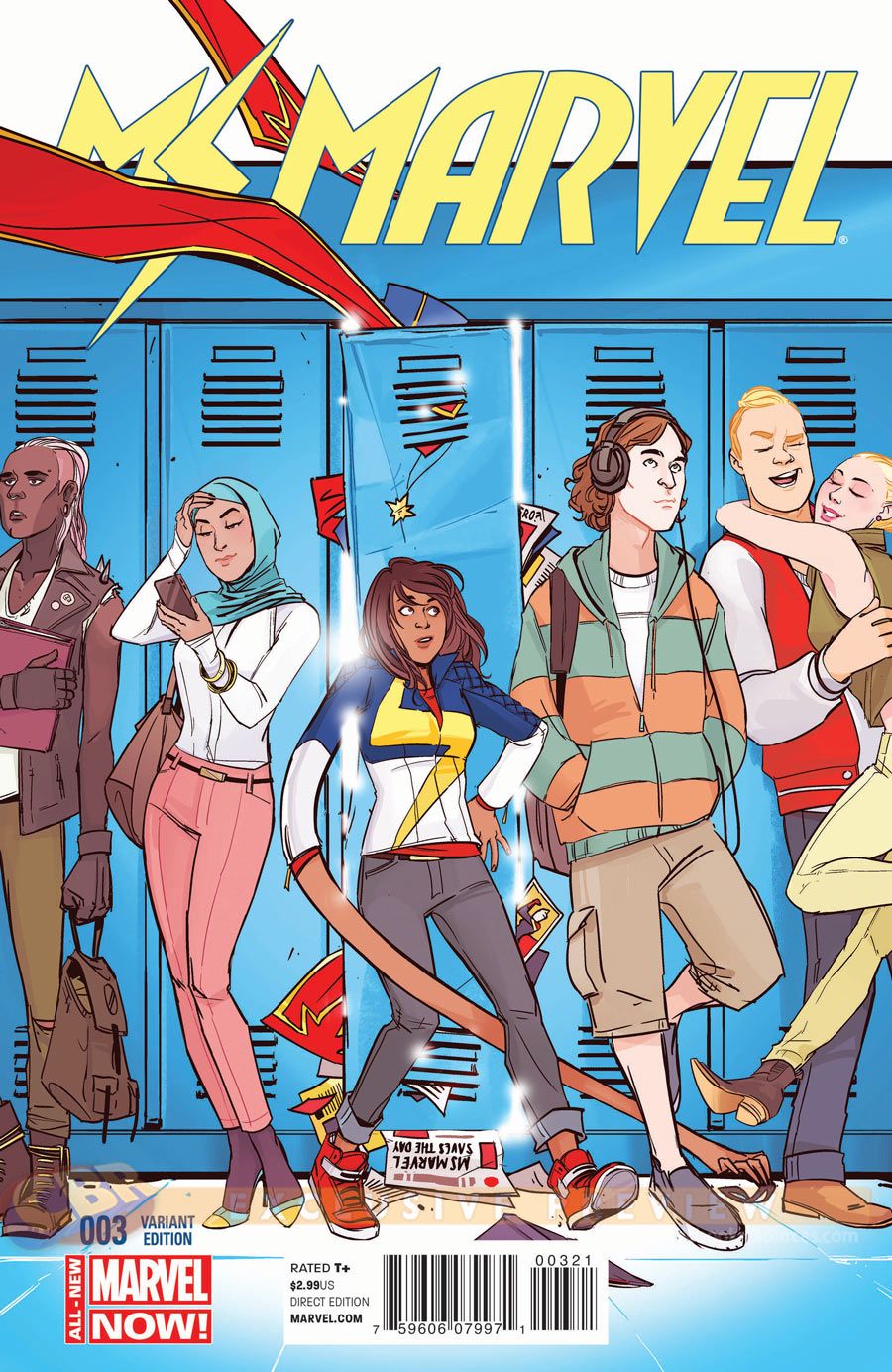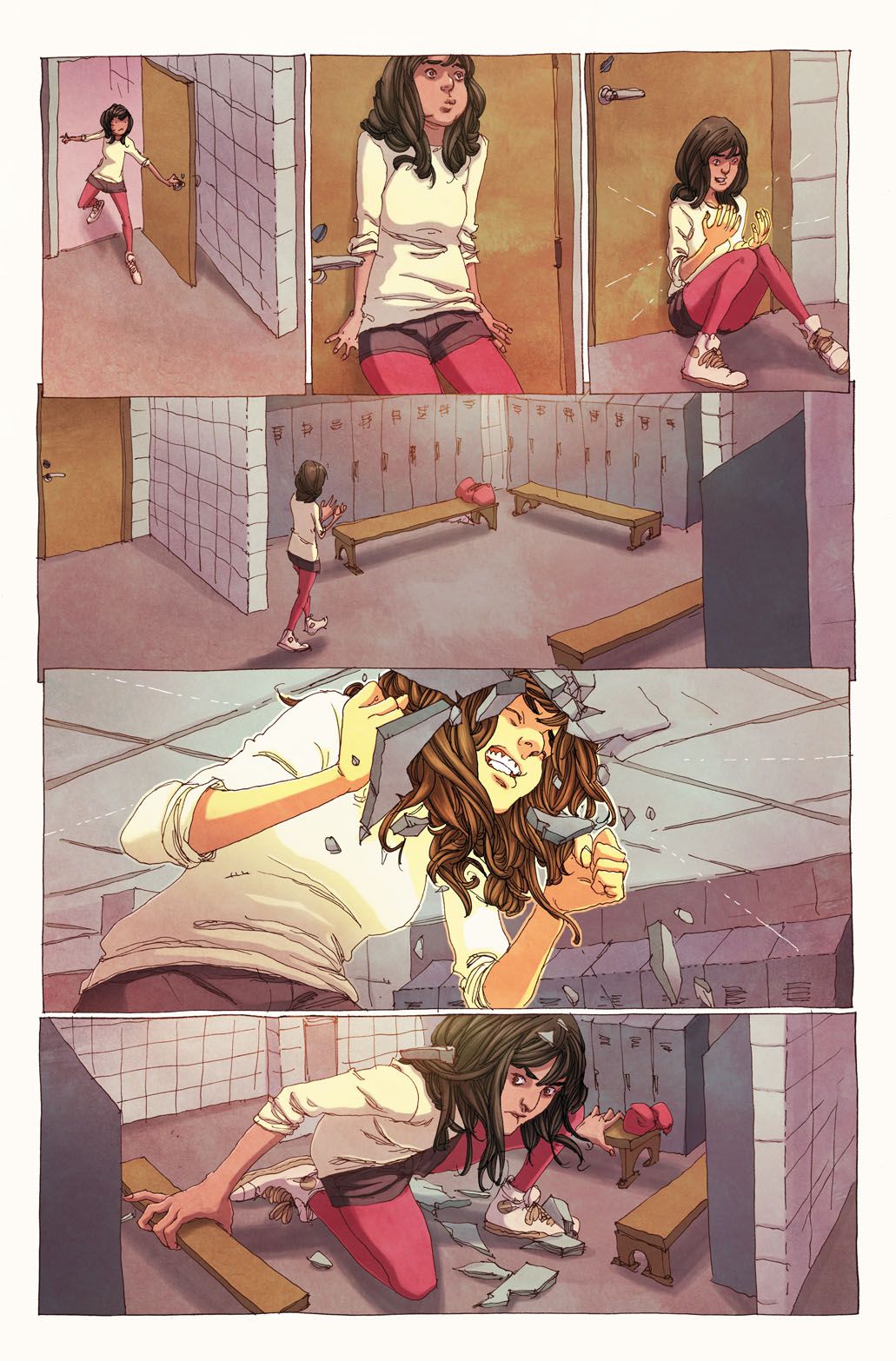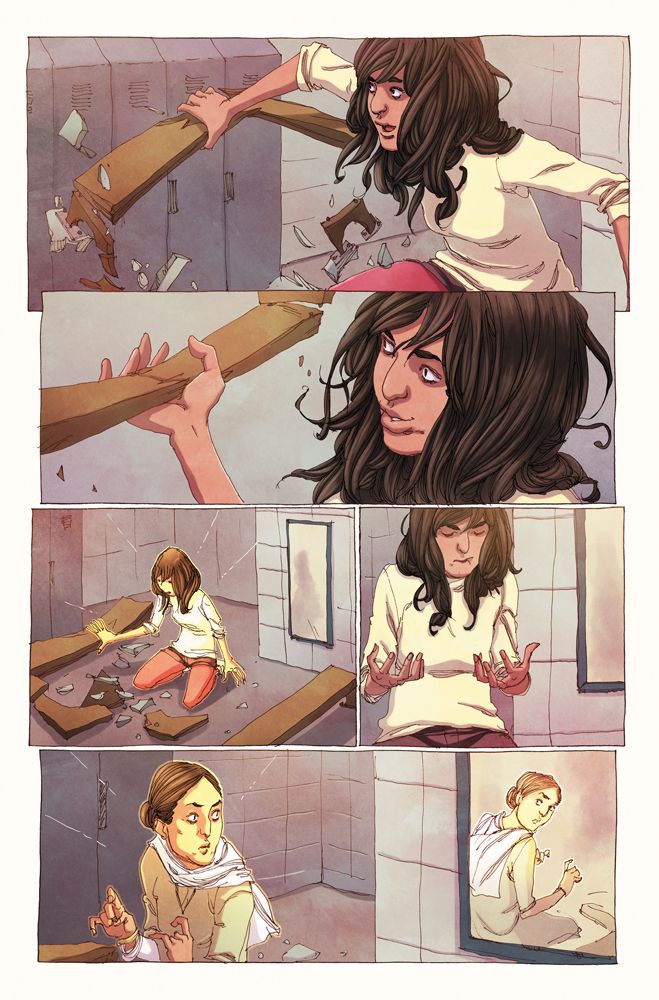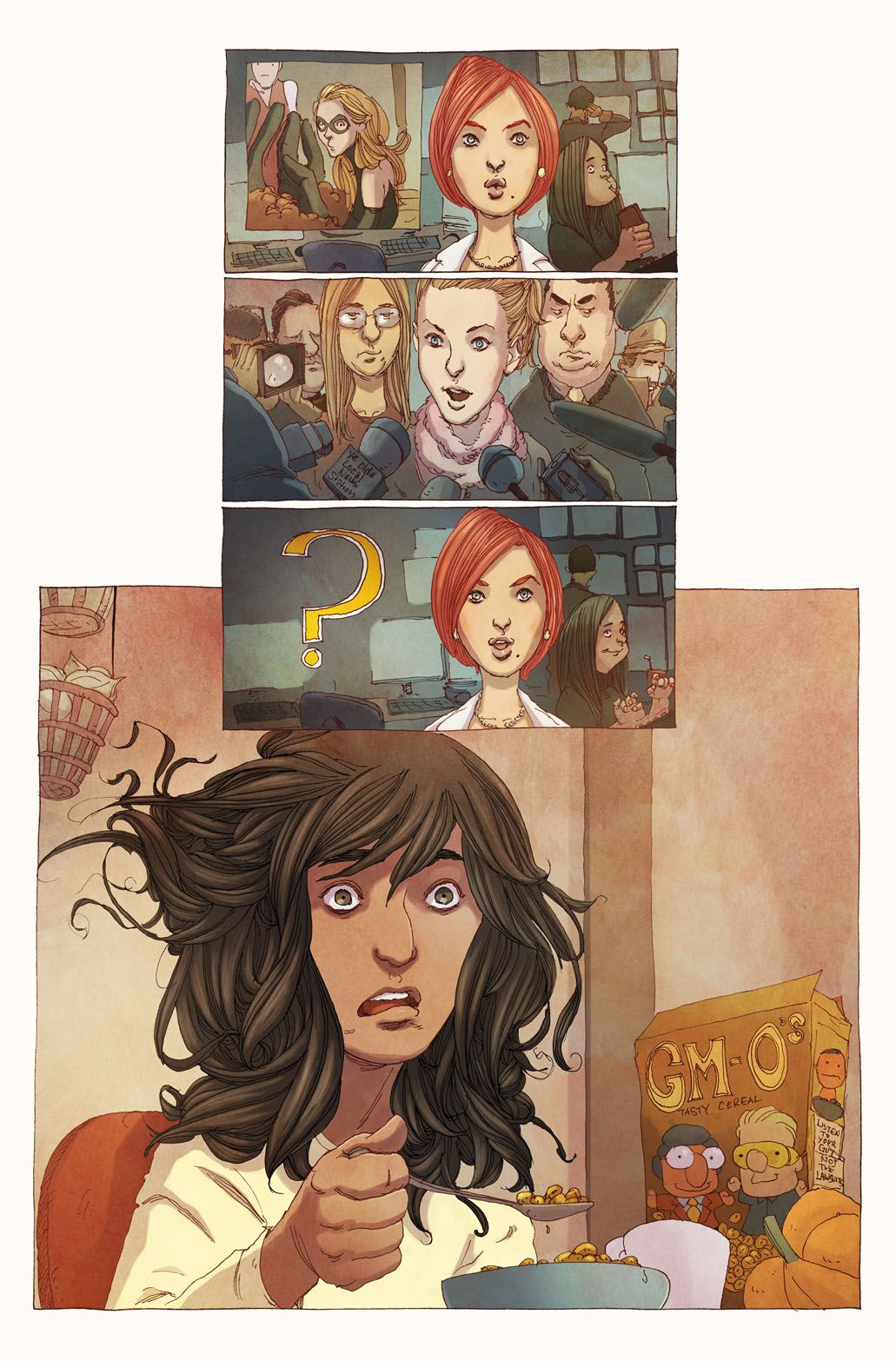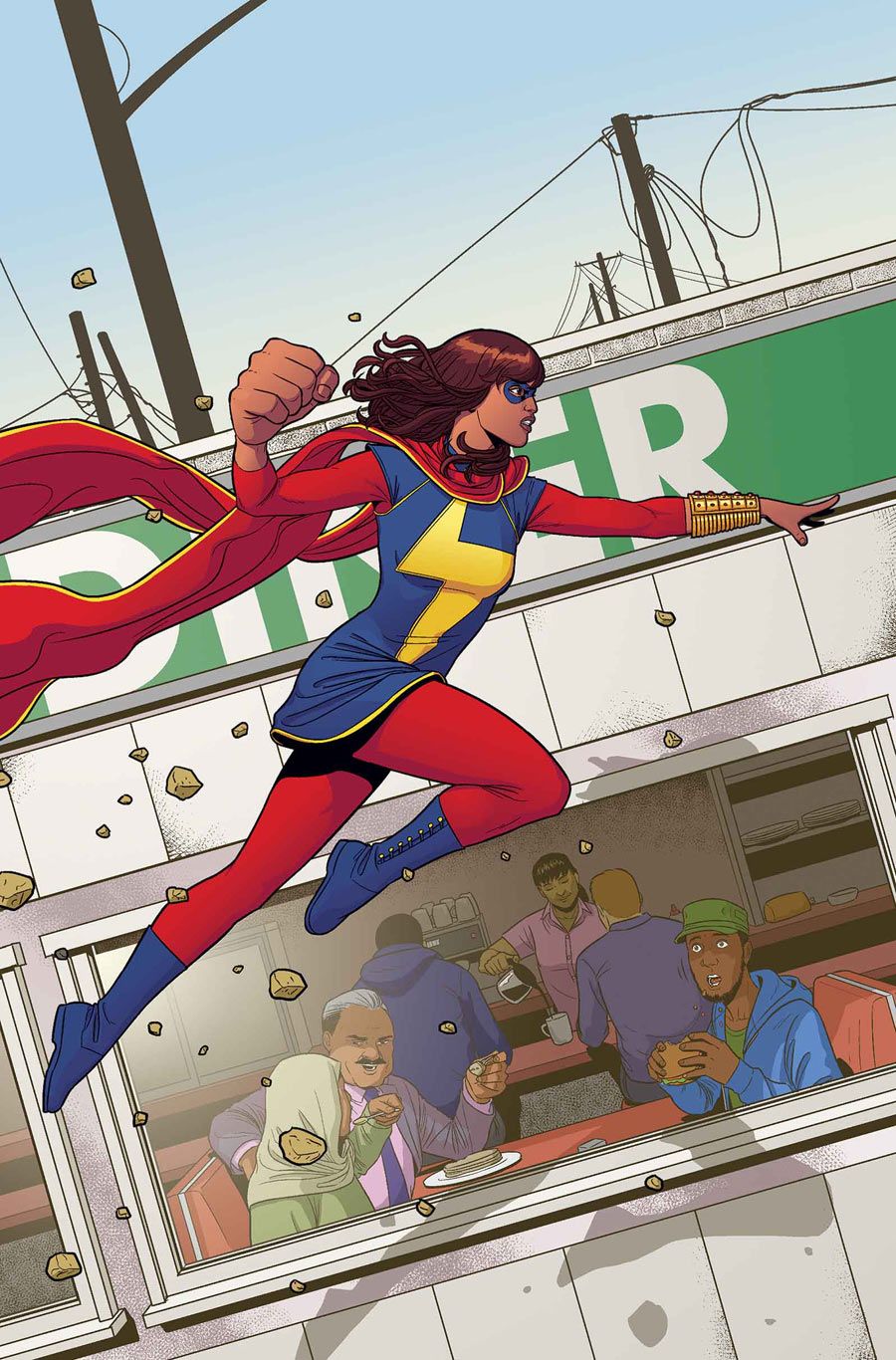Adolescence is a turbulent, exciting and often frightening time for kids. It's where they start to shape their identity and discover who they are as a person, which is difficult enough for your average high schooler, but what if you suddenly found yourself with the ability to become whoever and whatever you wanted to be? And what if you used your shape-shifting powers to take up the mantle of a super hero you adored?
Writer G. Willow Wilson and artist Adrian Alphona are answering these questions and more in the inaugural arc of Marvel Comics' new, ongoing "Ms. Marvel." The series chronicles how Jersey City resident Kamala Khan, the teenage daughter of Pakistani immigrants, was transformed into a shape-shifting polymorph and her decision to take up the mantle of the title character.
CBR News: What's made the first two issues of this series resonate with me, and I think a lot of other readers, is that essentially, the series is about a really likable teenager trying to find her place in a fantastic, but grounded world. I've used the elevator pitch "John Hughes meets the Marvel Universe" to describe the book to friends. Is that more or less what you were aiming for?
G. Willow Wilson: What we really wanted to do was create a believable, well rounded character in a setting that people could identify with. We really weren't interested in doing a sort of model minority book in which we had a cardboard cutout character that was spouting one-liners. We really wanted to make sure that she was a recognizable teenager, not just to comic book readers, but hopefully to other teenagers as well. We wanted her to feel authentically 16 years old.
So yes, I think the John Hughes comparison is very flattering. I'll take it. [Laughs] We really were going for that high school vibe where that's the environment you're in and those are the characters that you're encountering. So yeah, I love it. It's great.
Kamala Khan is a teenager, so she's trying to discover who she is. Suddenly, she's given the ability to become anyone or anything. When you were creating the character, was Kamala always intended to be a polymorph?
Her power set was probably the most difficult part of the character to create. We went back and forth about what her power set should look like. It was a very difficult thing. I've never before tried to make a super hero from scratch. I've always worked with established super heroes in the past.
Trying to think what those powers might be and what the limitations on those powers might be was very interesting. We knew going in that we wanted her to have very physical, kinetic powers. We didn't want her to be another sparkly telepath who floats in the air and shines. [Laughs] We wanted her to have powers that were interesting to look at on the page and that were sort of unexpected for a female character. It's most often male characters that get the dramatic growing, shrinking, stretching powers, because those aren't pretty powers.
The more we thought about this character, the more we thought that making her a polymorph might nicely parallel, in a metaphorical sense, a lot of her struggles in her non-super hero life. Shape-shifters in comics are most often cast as villains; characters like Mystique and Morph. We're naturally suspicious of people with fluid identities. We assume they must be hiding something.
Ironically, the people who get the explosive and destructive powers are most often good guys. The people that can shoot bolts of lightning, manipulate fire and shoot laser beams from the eyes are most often good guys. So we're sort of turning two sets of stereotypes on their heads; the stereotype about what the life of a young, American, Muslim girl must look like and what a polymorph must look like.
It seems like Kamala's powers could be both a blessing and a curse to her self-image.
Absolutely, part of being a teenager for most people, I think, is at points wishing you could be someone else. You think, "I have the wrong hair. I don't have the greatest skin. I'm not the right height. I'm not the right weight." There's all this pressure at that age to fit in with your peer group and fit into that expectation. So, what if you put on another face or take on another form? Would that really solve your problems? Does it really make all that disappear? It's a very interesting question, specifically for that age group.
Another interesting aspect of Kamala is, unlike many other teen Marvel heroes, she's starting her heroic career living in a house with both parents and a sibling. It seems like it would be hard to maintain a secret identity in that environment.
[Laughs] I really didn't think about the fact that it's very rare to have a young super hero in a nuclear family. Usually, there's some tragic back story. They're an orphan, or one parent is alive and the other has died, or they're being raised by grandparents or foster parents. So that's very strange.
The secret identity aspect of the character was something we thought a lot about, too, because the trend now is to have "out" super heroes. They don't wear masks. We know who their identities are. That's a lot of the Avengers. We've got Tony Stark. We've got Captain Marvel, who everybody knows is Carol Danvers, and Thor is Thor.

So the trend now is to have super heroes who are out in the open and have people know their real names, but with Kamala, since there's so much that she's juggling in terms of acceptance by her community and her parents, and the fact that she's so young, we thought it would make much more sense for her to hide her identity. So we put her in a mask.
It might seem somewhat counterintuitive to have a polymorph in a mask. [Laughs] But you'll find out why that is starting in Issue #4.
Kamala is closest with her father, Yusuf. Is her heroic behavior inspired by his kindness and decency in the same way Spider-Man's was inspired by his late Uncle Ben's compassion and humanity? In "Ms. Marvel" #2 she was moved into action by that great quote from the Quran that her father recited.
Yes, that's sort of her, "With great power comes great responsibility." We absolutely referred to that scene as an "Uncle Ben moment," so he is a bit of an Uncle Ben figure. I think part of the hero's journey of a lot of super heroes is figuring out what to do once they have these powers. What does it mean? What are they meant to do? There's usually some sort of aspirational figure in their lives that does provide that moral center.
So he is that, for sure. It's a little complicated, as we've already seen in the first two issues, because there is a bit of culture and generation clash between them. He's from a different generation and he's also originally from Karachi. So he has a different cultural outlook than his daughter, who is a Jersey Girl in a lot of ways. There's a lot of tension between those two characters. She looks up to him and he loves her, but at the same time, there are issues between them that they have not worked out.
It seems like one of the reasons Kamala and her dad get along so well is that they're both comfortable with their current living situations. Are her mother and brother as comfortable? Their dialogue and actions in the first two issues suggest that they might not be.
With the family, what we wanted to have is a diversity of opinions and have them not all be cut from the same cloth; to show that within this community, that many readers might not be familiar with, it's not a monolith. People believe, practice and interact with the world in very different ways.
Her older brother is very pious, and a bit of a stick in the mud. Her father is much more pragmatic. He'd love for his son to kind of leave the nest, go and get a job and kind of grow up. We also see that the older brother might be a bit of a mama's boy. She's the one who rushes to his defense, whereas Kamala is closer with her dad.
You can see within this family, as within all families, there are subtle alliances. There's friction. There are competing ideologies and competing aspirations. We wanted to have that, so there was not a clear cut hierarchy; that there was recognizable family love and family tension within that family.
From what we saw of Kamala's friend Nakia in Issue #1, she seems a little more self-assured than Kamala.
Yes, definitely. She's Turkish American, and she's very much embracing her Turkish side. She talks a little bit about wearing the Hijab, which she hints that she did over the objections of her parents when Zoe asks her about it. She asks to be called by her name, not this sort of Americanized nickname. With Nakia, we have somebody who's growing into an identity as an empowered, proud, young, American, Muslim woman, whereas Kamala is much more ambivalent. In certain ways, she's very visibly pulled in multiple directions. She has multiple loyalties, and the people that she loves are a fairly diverse group. So, Kamala, I think, is a little more complicated, and at times that means that she is a little hesitant.
We know from the "All-New Marvel NOW! Point One" story that Bruno is eventually going to become Kamala's confidant with her secret identity, and in Issue #1, he appears to become a little sad when Kamala gets irritated with him and suggests that if he were Pakistani, her parents would approve of him. So I have to wonder, going back to my John Hughes analogy -- is Bruno Kamala's Ducky from "Pretty In Pink?"
[Laughs] Well, I don't want to give too much away, but yeah, I think it becomes clear pretty early on that Bruno may have certain feelings for Kamala of which she is completely oblivious. So yes, there's definitely that tension there.
How big of a supporting character will the Jersey City setting be in "Ms. Marvel?" It's interesting that the Avengers, who Kamala adores, live so close to her. Is there a sense of a fantastic place that's really close, but just out of reach?
That's exactly right. That's part of the reason that we chose Jersey City; because Manhattan, in a lot of ways, is kind of the epicenter of super hero life in the Marvel Universe. Kids right across the river -- and this mirrors the cultural gap between New Jersey and New York in a lot of nice ways -- would constantly feel like they were literally living in the shadow of these fantastical things that are taking place right across the river. And yet, they're often over looked.
It's a very diverse city. It's a little more working class, so I think there's a potential there for some very unique storylines that have not been explored, typically, in the Marvel Universe. There's also so much great pop cultural and sub cultural lore in New Jersey. Of course, you have Kevin Smith. There's kind of a shout out to him in Issue #1. There's a Chatty Bob working at a convenience store. People who are devotees of Kevin Smith will immediately identify him as an homage to Silent Bob from the films. There's a really rich, fun, mine of Jersey related pop culture there.
What can you tell us about the remaining action in this initial arc of "Ms. Marvel? Will it feature any super villain antagonists in the traditional sense?
This first arc, which is five issues, is primarily about Kamala growing into herself. In issues #4 and #5 we'll start to see hints of the super villain she'll have to face.
Is that villain connected to the giant trash monster we saw in the "All-New Marvel NOW: Point One" story?
Again, I don't want to give too much away, but the "Point One" story was constructed that way for a reason. [Laughs]
Let's start to wrap things up by talking about the work of your artistic collaborators, Adrian Alphona and colorist Ian Herring. Which of their artistic strengths are on display in these next few issues?
I think they're both so perfect for this book. Adrian and I were in total mind meld about the look and feel of the series from the very beginning. A lot of the sight gags in the series are his not mine. Instead of having a Teddy Bear in her room, Kamala has that stuffed sloth with wings. And Hedge Hulk was this sort of figure in the margins of a sketch that he did that got published in The New York Times. Then everybody on Twitter was like, "When are we going to see Hedge Hulk?" So Hedge Hulk has become this recurrent thing.
We both had the same idea that this was not going to be a grim, dark, "What does it all mean?" postmodern series. It was going to be a little more lighthearted and self conscientiously funny. It wouldn't shy away from serious issues, obviously, but it's taking them all with some air.
Adrian is perfect for that. He has such a fine, deft touch with his pencils that it would be really easy to color them in a really stupid way, but what Ian does is so perfect in terms of complimenting the art. I love that everything is not shiny and reflective. He uses a lot of flats. He uses a lot of beautifully muted colors. The palette is just perfect. I could not imagine two better collaborators for this series.
Finally, we've talked quite a bit about your initial "Ms. Marvel" story, but what awaits Kamala further down the road? If you were to make a "This season, on 'Ms. Marvel'" clip reel, what sorts of image would be in it?
Well, we know that Kamala has not yet gotten a costume. My favorite part of super hero movies is the training montage, at the end of which they emerge, all suited up. This is really an origin story in the best sense of the word, at the end of which, you'll see exactly what she's capable of and exactly what she's up against.

